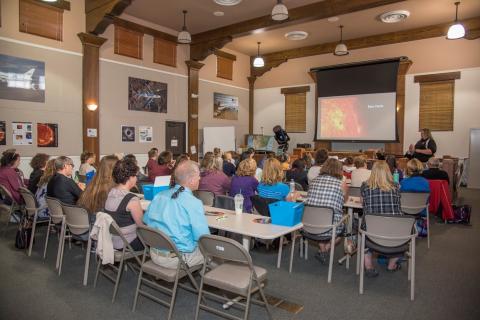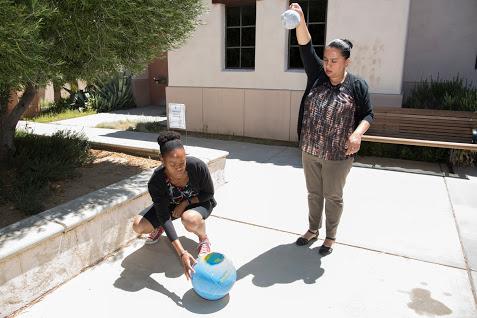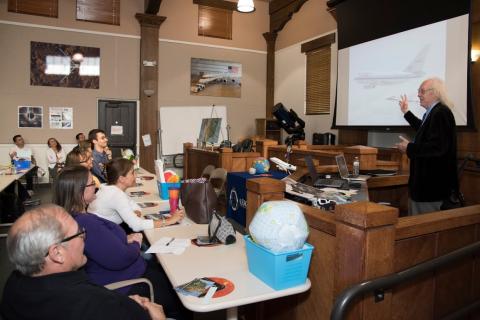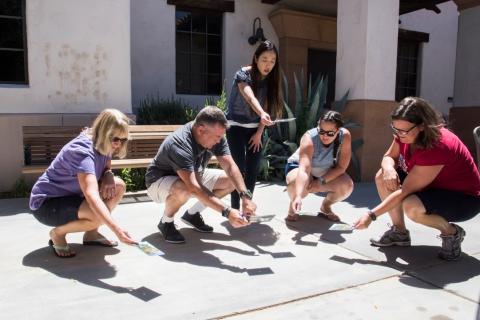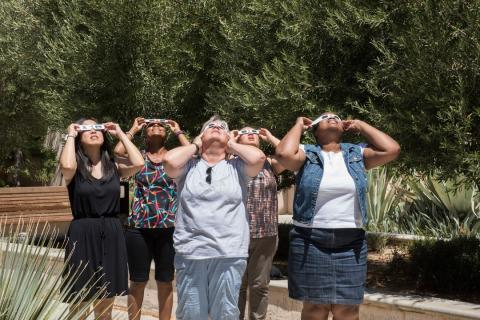NASA Armstrong Flight Research Center’s Office of Education at the AERO Institute in Palmdale, California, has presented multiple solar eclipse workshops to regional educators to provide the resources needed to teach students about the first solar eclipse to be visible across all of North America in nearly 40 years. Educator Professional Development Specialist Dr. Barbie Buckner led the workshops providing the science behind eclipses and using demonstrations to explain eclipses to students.
Using the Explore Science: Earth & Space toolkit, educators did the Solar Eclipse activity where they used a flashlight to cast a tennis ball’s shadow onto a beach ball, which simulated the sun casting the moon’s shadow onto the Earth during an eclipse. With the Bear’s Shadow activity, educators used a flashlight to move a toy bear’s shadow — which demonstrated how shadows change as light sources move. With the Big Sun, Small Moon activity, educators used a tennis ball and a beach ball spaced out to simulate how a small object such as the moon has the ability to block out a larger object such as the sun.
Cherise Robinson, a teacher from the iLEAD Lancaster Charter School in Lancaster, California, said the workshop gave her valuable teaching resources. “The workshop was fascinating,” she said. “I’m super excited about the upcoming event and about having a modality (or method) of delivering to my kids.”
At the May 10th workshop, Dr. Eric Becklin, chief science advisor for the Stratospheric Observatory for Infrared Astronomy, or SOFIA, which is a joint project between NASA and the German Aerospace Center that uses a 747 aircraft with an onboard telescope, spoke to workshop participants about his experiences observing solar eclipses. “It was otherworldly,” Becklin said about a total solar eclipse he viewed from Hawaii’s Mauna Kea volcano. “I couldn’t believe how much the landscape looked like the moon!”
Becklin told how he participated in a 1988 solar eclipse observation just north of Guam aboard the Kuiper Airborne Observatory, a predecessor to SOFIA. The 1988 observation took advantage of the eclipse’s unique lighting conditions to glean data about the sun’s atmosphere. He urged workshop participants to witness the August 21st eclipse for themselves saying “go see the solar eclipse, make sure you look at it and enjoy the feeling of it.”
Kathleen Fredette, director of STEAM Initiatives for iLEAD Schools and SOFIA airborne astronomy ambassador, said Dr. Becklin’s stories inspire listeners to learn more about astronomy. “Dr. Becklin is always amazing, and his storytelling is beautiful,” she said. “He makes you want to understand the hard stuff.”
Multiple educator workshops have been hosted throughout May and June. The May workshop included 45 educators, 25 educators participated in the virtual June webinar, and the in-person workshops in June consisted of over 50 more educators.
For more information about NASA Armstrong Flight Research Center's Office of Education and educator workshops, please contact Barbie Buckner at [email protected].

